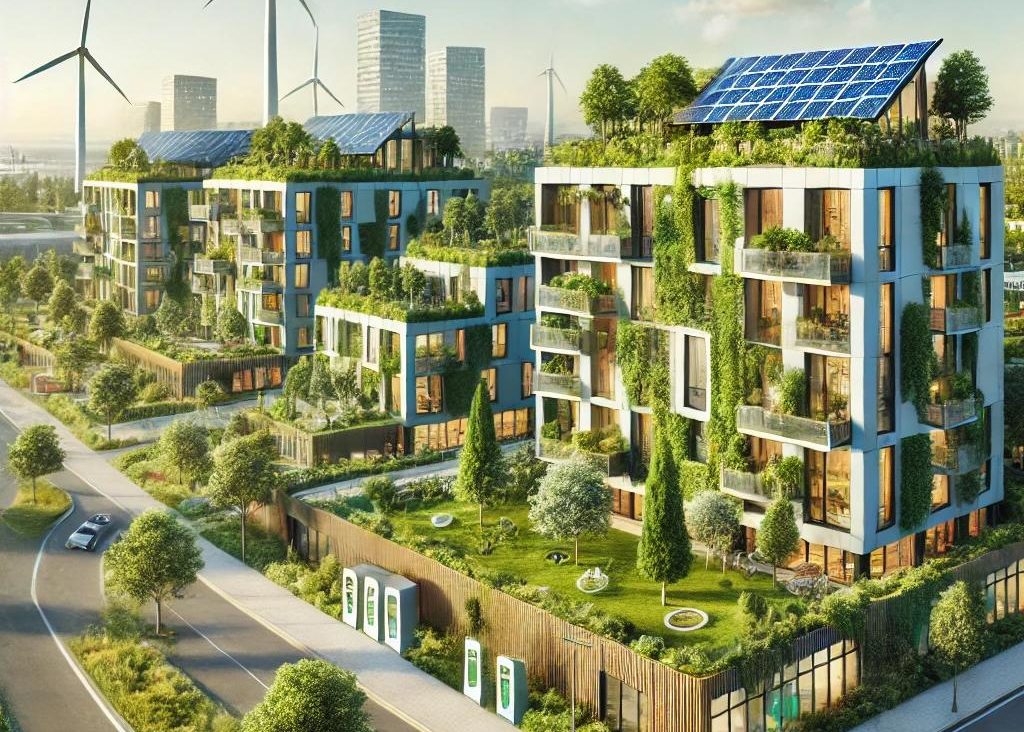Sustainable Real Estate Development: Trends in Green Building
As concerns about climate change and environmental impact continue to rise, the real estate industry is at the forefront of embracing sustainability. Sustainable real estate development, mainly green building, has evolved from a niche market to a mainstream trend driven by regulations, investor interest, and consumer demand. The push for eco-friendly, energy-efficient buildings has never been stronger, and several trends are shaping the future of the industry. Here’s a look at the key trends in green building for 2024.
—
1. Net-Zero Energy Buildings (NZEBs)
Net-Zero Energy Buildings (NZEBs) are becoming the gold standard in sustainable real estate development. These buildings produce as much energy as they consume by utilizing renewable energy sources like solar or wind power, in addition to maximizing energy efficiency through advanced technologies.
– Why It’s Growing: Governments and municipalities across the US are increasingly mandating NZEB standards for new construction. For instance, California has introduced legislation requiring all new commercial buildings to be net-zero by 2030.
– Technology in Focus: Smart HVAC systems, high-performance windows, and advanced insulation materials are making achieving net-zero status in residential and commercial buildings easier.
—
2. The Rise of Passive House Design
The Passive House (Passivhaus) concept is gaining traction due to its focus on ultra-low energy use and superior indoor air quality. Unlike other green building approaches, Passive Houses emphasize design principles that minimize a building’s energy requirements.
Key Features include super-insulated walls, airtight construction, and high-efficiency ventilation systems. These features reduce the need for heating and cooling by up to 90%.
– Market Growth: In the US, cities like New York and Seattle are seeing an increase in Passive House projects due to stricter environmental regulations and incentives for energy-efficient construction.
– Example: The Cornell Tech Campus on Roosevelt Island in New York is home to the world’s largest Passive House-certified residential building.
—
3. Biophilic Design and the Integration of Nature
Biophilic design, which integrates natural elements into the built environment, is a growing trend in sustainable real estate development. This design philosophy enhances the connection between people and nature, improving well-being while supporting sustainability.
– Design Elements: Green roofs, living walls, indoor plants, and natural lighting are key features of biophilic design. These elements not only promote mental health but also contribute to energy savings by improving insulation and reducing reliance on artificial lighting.
– Why It Matters: Studies show that buildings designed with biophilic elements can increase productivity, reduce stress, and create healthier environments for occupants.
– Popular Projects: Buildings like The Spheres at Amazon’s headquarters in Seattle and Bosco Verticale in Milan are leading examples of biophilic architecture in action.
—
4. Sustainable Materials and Circular Economy Practices
The construction industry has traditionally been one of the largest consumers of raw materials. However, developers increasingly turn to sustainable materials and circular economy practices, which aim to reduce waste and reuse resources.
– Sustainable Materials: Materials like reclaimed wood, recycled metal, and low-carbon concrete are rising. These materials have a significantly lower environmental footprint than traditional materials like steel and cement.
– Circular Economy: This concept promotes the reuse, recycling, and repurposing of materials throughout a building’s lifecycle. Buildings are now designed with future disassembly in mind, allowing materials to be reclaimed and reused rather than discarded.
– Trend Example: Mass timber construction in commercial and residential buildings is becoming increasingly popular, with cities like Portland and Vancouver pioneering mass timber skyscrapers.
—
5. Smart Buildings and Energy Efficiency
Smart building technology will play a crucial role in green real estate development. Smart buildings use sensors, automation, and data analytics to optimize energy use, improve water efficiency, and manage waste systems more effectively.
– Smart HVAC and Lighting: By leveraging artificial intelligence (AI) and Internet of Things (IoT) technology, smart buildings can automatically adjust heating, cooling, and lighting based on occupancy, reducing unnecessary energy use.
Building Management Systems (BMS) are integrated systems that monitor and manage a building’s operations, from energy consumption to water usage, helping ensure that buildings run as efficiently as possible.
– Impact: According to the US Green Building Council (USGBC), smart building technology can reduce a building’s energy consumption by up to 30%.
—
6. Water Conservation and Management
Water scarcity continues to be a pressing issue, particularly in regions like the western United States. As a result, sustainable real estate developers are increasingly incorporating water-efficient technologies and practices into their projects.
Water Recycling Systems: Greywater recycling and rainwater harvesting systems are becoming more common in new developments, helping to reduce the demand for municipal water supplies.
Xeriscaping: Landscaping using drought-resistant plants is gaining popularity in areas with more pronounced water shortages, such as California, Arizona, and Nevada.
– Innovative Solutions: Buildings are now designed with water-efficient fixtures such as low-flow toilets, intelligent irrigation systems, and water-efficient dishwashers.
—
7. Electrification and the Move Away from Fossil Fuels
As part of the push toward sustainability, real estate developers focus on electrification—moving away from fossil fuels for heating, cooking, and transportation within buildings.
– All-Electric Buildings: These buildings rely on electricity for all energy needs, including heating, cooling, and cooking, and are often paired with renewable energy sources like solar panels.
– Transportation Integration: The rise of electric vehicles (EVs) also influences real estate development, with more buildings incorporating EV charging stations into their infrastructure.
– Legislation: Cities like San Francisco and Berkeley have banned natural gas hookups in new buildings, paving the way for fully electrified developments.
—
8. Health and Wellness-Centered Design
With the COVID-19 pandemic reshaping how people view indoor environments, there has been a heightened focus on designing buildings prioritizing occupant health and wellness. This trend is now merging with sustainability efforts.
– Indoor Air Quality: Green buildings prioritize better indoor air quality through advanced filtration systems, natural ventilation, and low-VOC (volatile organic compound) materials.
Well Certification: The WELL Building Standard, which focuses on occupant health and well-being, is increasingly being adopted alongside traditional green building certifications like LEED.
– Examples: Developments are incorporating wellness features like circadian lighting, ergonomic workspaces, and communal green spaces to enhance physical and mental health.
—
Conclusion
As we move into 2025, sustainable real estate development continues to evolve, with new trends like net-zero buildings, biophilic design, and smart technology leading the charge. These innovations reduce environmental impact and enhance the health, well-being, and productivity of building occupants. Investors and developers who prioritize sustainability will help combat climate change and position themselves at the forefront of a growing demand for eco-friendly, energy-efficient, and resilient real estate.
The green building movement is no longer a future concept—it is the present, reshaping the landscape of real estate development worldwide. In 2024, sustainable practices will be not just a moral obligation but a profitable and essential part of real estate strategy.




Leave a Reply